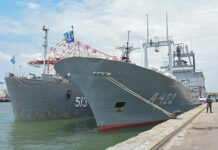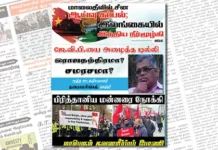Sri Lanka has deployed thousands of troops and police to enforce a curfew after five people were killed in the worst violence in weeks of protests over an unprecedented economic crisis.
Nearly 200 people were wounded on Monday as prime minister Mahinda Rajapaksa resigned, but that did little to calm public anger.
Rajapaksa had to be rescued in a pre-dawn operation by the military on Tuesday after thousands of anti-government protesters stormed his official residence in Colombo overnight, with police firing teargas and warning shots to keep back the crowd.
Protesters who forced their way into the capital’s “Temple Trees” residence then attempted to storm the main two-storey building where Rajapaksa was holed up with his immediate family.
“After a pre-dawn operation, the former PM and his family were evacuated to safety by the army,” a top security official told AFP. “At least 10 petrol bombs were thrown into the compound.”

Rajapaksa’s evacuation to an undisclosed location followed a day of violent protests in which five people, including a lawmaker, were killed and nearly 200 wounded.
The security official said police kept up a barrage of teargas and fired warning shots in the air to hold back mobs at all three entrances to the colonial-era building, a key symbol of state power.
Dozens of homes of top Rajapaksa loyalists were torched elsewhere in the curfew-bound country, which has been under a state of emergency since Friday.
The emergency order from president Gotabaya Rajapaksa, the outgoing premier’s younger brother, gave sweeping powers to the military as protests demanding the duo’s resignation escalated over the country’s worst-ever economic crisis.
Protesters and Sri Lankan religious leaders blamed the former prime minister for instigating the family’s supporters to attack unarmed protesters on Monday, sparking retaliatory attacks.
Rajapaksa’s resignation follows months of protests over the country’s deepening economic crisis, as once-peaceful protests turned violent. Turmoil began to engulf the country on Monday after violence at a major protest site in Colombo, where pro-government supporters attacked demonstrators and police responded with teargas and water cannon.
In one incident just outside Colombo, a politician from the ruling party opened fire on anti-government protesters blocking his car, killing a 27-year-old, and then later took his own life. According to police, another ruling party politician opened fire on protesters in the southern town of Weeraketiya, killing two and wounding five.
Mahinda Rajapaksa had been asked to resign by his brother at a special meeting on Friday, in an attempt to appease demonstrators who have been taking to the streets in their thousands since March.
Protesters have been calling for both members of Sri Lanka’s powerful Rajapaksa political dynasty to be removed from office for mishandling the economy and plunging the country into the worst financial crisis since independence.
Mahinda Rajapaksa, who was president himself for a decade between 2005 and 2015, had reportedly been resistant to stepping down, but on Monday submitted his letter of resignation to the president.
“Multiple stakeholders have indicated the best solution to the present crisis is the formation of an interim all-party government. Therefore, I have tendered my resignation so the next steps can be taken in accordance with the constitution,” he wrote.
The resignation is the latest concession made by the Rajapaksas in the face of protracted anger and protests. The president recently agreed to repeal an amendment to the constitution which had concentrated power in his hands and hand power back to the parliament. Other members of the Rajapaksa family who had previously held seats in the cabinet have also stepped down, with the president the only remaining member of the political family still in power.
Gotabaya Rajapaksa, known widely as Gota, has repeatedly said he will not resign as president, despite the clarion call of the protests being “Gota go home”.
The Rajapaksas have largely controlled Sri Lankan politics for two decades, but the economic crisis has rattled their grip on power in the face of mass unrest from those who had previously been supporters of their brand of chauvinist nationalist politics, which pandered to the country’s Sinhalese Buddhist majority.

Sri Lanka’s foreign reserves have dropped so low that the country cannot afford to import basic essentials, leading to shortages of fuel, food and medicines. People have been forced to endure daily power cuts of up to 10 hours, fuelling mass protests across the country since March.
Over the weekend, the president declared a state of emergency in the country, the second in recent weeks, in a bid to regain control over the streets.
However, Monday marked a violent shift in the demonstrations when hundreds of pro-government supporters gathered outside the prime minister’s residence in Colombo and urged Mahinda Rajapaksa not to resign. The group, some armed with sticks and wooden bars, then launched an attack on an anti-government protest camp nearby, with police reportedly looking on as the clashes began.





